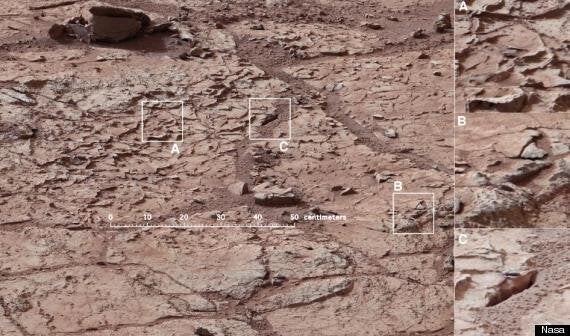Nasa's Mars rover Curiosity is preparing to drill its first rocks on the Red Planet's surface.
Its first target is an outcrop that was once "soaked" in water, the space agency said.
The one ton, $2.5 billion rover will drill ionto a site named "John Klein" in tribute to a former engineer at the Curiosity project, where there is evidence that water once flowed over the surface.

Above: The 'John Klein' site selected for the drilling attempt
"Basically, these rocks were saturated with water," Curiosity chief scientist John Grotzinger told reporters, according to Space.com.
It is hoped that the samples collected from rocks on the surface could hold evidence that life - or the conditions for it - once existed on the dry, dusty planet.
But at first the samples will be used simply to scrub the drill, before more rock fragments are collected for study.
No rocks have ever been drilled into on Mars.
"Drilling into a rock to collect a sample will be this mission's most challenging activity since the landing. It has never been done on Mars," said Richard Cook of NASA's Jet Propulsion Laboratory.
"The drill hardware interacts energetically with Martian material we don't control. We won't be surprised if some steps in the process don't go exactly as planned the first time through."
The site was picked by Nasa because imagery from an orbiting space craft showed it cooled more slowly at night than nearby terrain, indicating it was once a different kind of wet environment than nearby sites.
Nasa said of the local area:
Researchers have used the rover's Mars Hand Lens Imager (MAHLI) to examine sedimentary rocks in the area. Some are sandstone, with grains up to about peppercorn size. One grain has an interesting gleam and bud-like shape that have brought it Internet buzz as a "Martian flower." Other rocks nearby are siltstone, with grains finer than powdered sugar. These differ significantly from pebbly conglomerate rocks in the landing area.